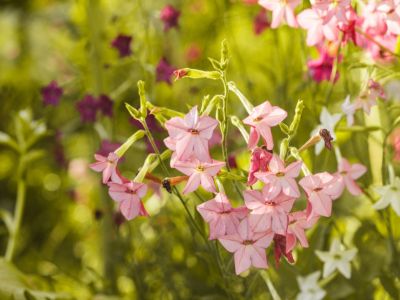Flowers of nicotiana, flowering tobacco (Nicotiana alata), are tubular shaped and grow moderately to quickly. Too much fertilization when growing nicotiana can lead to excessive growth of the petite plants causing them to get leggy and cease flowering or flop.
Growing the Nicotiana Plant
Nicotiana flowering tobacco is most often grown and sold as an annual plant although some species of the nicotiana flower are really short lived perennials. Plant seeds or seedlings into a sunny or partially shaded area of the garden with well-drained soil in late spring. Some species of the nicotiana flower may be short lived, providing attractive blooms for the early days of summer. Others may bloom until taken by frost. Be prepared to replace the nicotiana plant with a hot-weather annual or perennial. The blooming nicotiana flower is worthwhile as attractive 2 to 4 inch (5-10 cm.) blooms to decorate your sunny locations. Borne in clusters on multi-branching stems, the nicotiana flower grows in shades of white, pink, purple, and red. There is also the lime green petaled nicotiana flower of the Saratoga rose cultivar. Care of the nicotiana plant is basically watering and deadheading spent flowers to encourage the return of more brilliant blooms. While this plant will tolerate some drought, optimum flowering occurs in moist soil.
Cultivars of Nicotiana Plant
67 cultivars of flowering tobacco exist. The foliage of the nicotiana plant can be large, making the plant bushy.
The cultivar Alata has leaves that may grow to 10 inches (25 cm.), with up to 4 inch (10 cm.) blooms. This is one of the most fragrant varieties. Sylvestris may reach a height of 3 to 5 feet (1-1.5 m.) with fragrant white flowers. The Merlin series reaches only 9 to 12 inches (23-31 cm.) and is appropriate for use in a front border or as part of a container planting.
